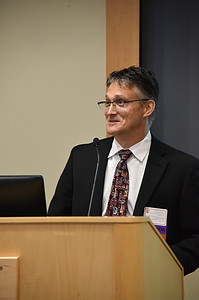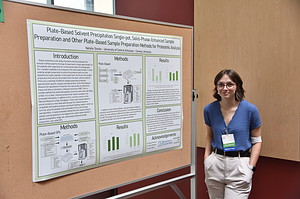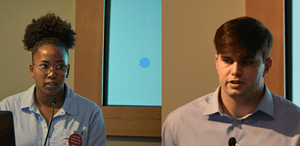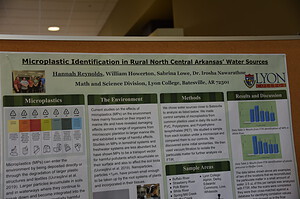View Larger Image
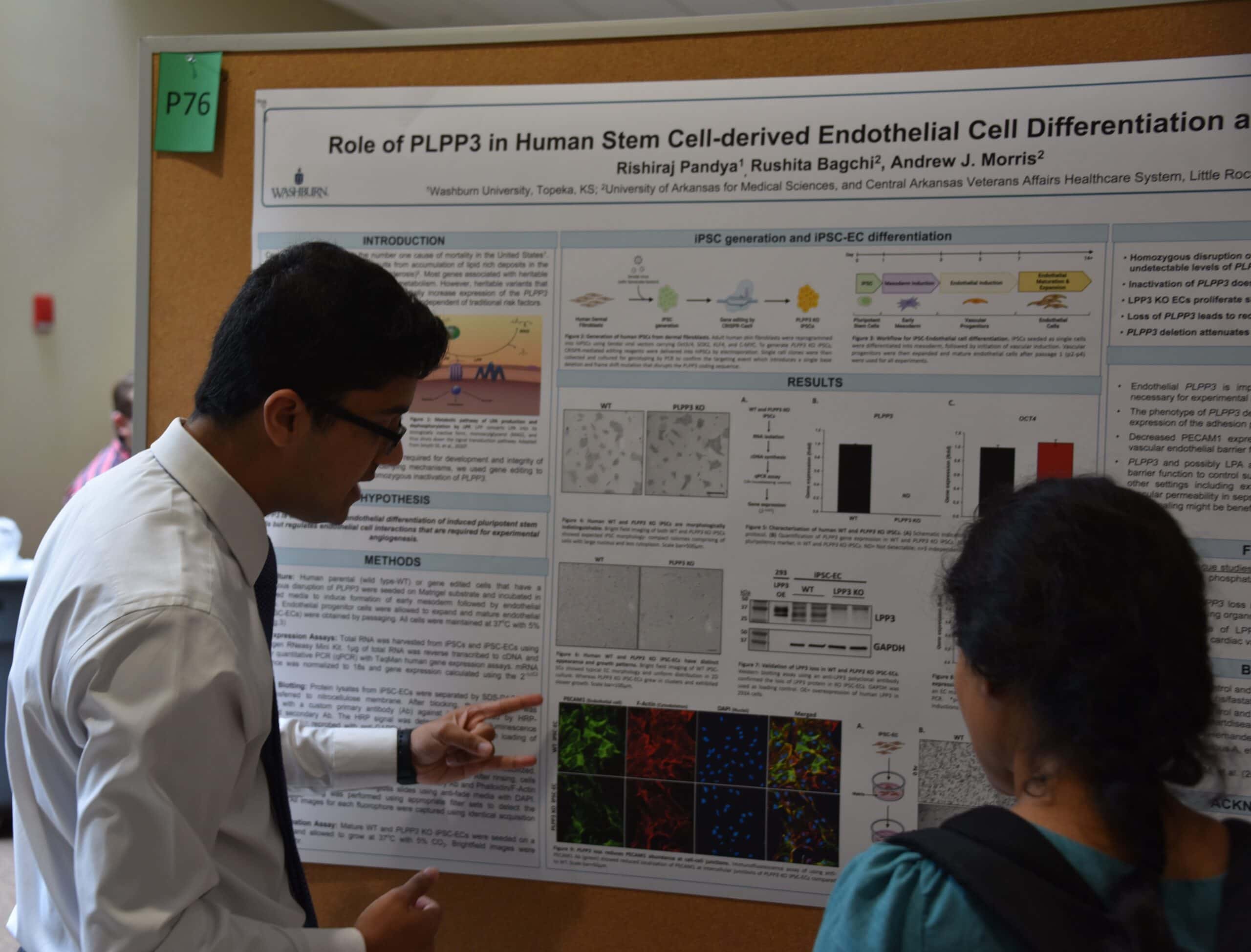
Rishiraj Pandya of Washburn University in Topeka, Kansas, discusses his poster.
Image by Nathan Tidwell
Enthusiastic Scholars Talk Science at Undergraduate Summer Research Symposium
| Students from 41 colleges and universities across the nation recently attended the 10th Annual Arkansas Undergraduate Summer Research Symposium at the University of Arkansas for Medical Sciences (UAMS).
The symposium celebrated achievements by undergraduates pursuing research in a wide range of biomedical-related topics. The UAMS Department of Biochemistry and Molecular Biology organized and sponsored the event with support from the UAMS Graduate School and the IDeA Networks of Biomedical Research Excellence (INBRE) program.
“We want to help prepare a new generation of researchers to solve the problems of tomorrow, especially in light of the pandemic in which science played a critical role in putting us on a path to recovery. Last year, there was high interest and participation that reached pre-pandemic levels,” said Grover Paul Miller, Ph.D., a professor in the College of Medicine Department of Biochemistry and Molecular Biology and the organizer of the symposium.
The 2023 symposium was the second consecutive year for the event following a two-year interruption due to the COVID-19 pandemic.
The event was held July 26 at the I. Dodd Wilson Education Building and backed by grant funding from the National Institute of General Medical Sciences. This time, there was over 130 student researchers registered with more than 100 faculty and administrators in support.
Undergraduate and high school students participated in 17 different research programs in colleges and universities, as well as the U.S. Food & Drug Administration’s National Center for Toxicological Research (NCTR) near Pine Bluff.
“This year is our largest number of student presenters,” Miller said in his opening. “Real research happens when you get to talk about the science you do, because it’s a lot of fun. There are a lot of things that work out really well, and a lot of things that do not. Science is about that journey, and this symposium is about talking about your journey to this day.”
The following students were selected to give oral presentations, which were divided into morning and afternoon sessions:
- Kennedi Burns, Hendrix College (Summer Research Internship Program)
- Kya Carroll, Hendrix College (Summer Undergraduate Research Program)
- Harrison Cook, University of Mississippi (INBRE)
- Braden Glenn, Lyon College (INBRE)
- Muzala Kawatu, Brown University (Summer Undergraduate Research Program)
- Christian Lu, Arkansas School for Mathematics, Sciences and the Arts (Summer Research Internship Program)
- Aiiryel McCoy, University of Arkansas at Little Rock (Professional Research Opportunity)
- Trace Morrow, Ouachita Baptist University (OBU Summer Research Program)
- Akshay Padala, Emory University (NCTR)
- Sreevatsav Seenivasan, University of Arkansas at Fayetteville (Summer Undergraduate Research Fellowship)
- Jordan Su, Case Western Reserve University (NCTR)
- Anna Vollintine, University of Arkansas at Little Rock (Summer Research Internship Program)
“These 12 were selected out of 45 submissions,” said Samantha Kendrick, Ph.D., a professor in the College of Medicine Department of Biochemistry and Molecular Biology. “I think they all did a fantastic job.”
Lu, one of the high school students participating in UAMS’ summer research programs, spoke on glioblastoma.
“Glioblastoma is a very common and aggressive type of brain cancer,” Lu said. “Treatment is limited to surgery, radiation therapy and chemotherapy. The problem with glioblastoma is that after treatment, the cancer will almost always come back due to the presence of cancer stem cells.”
Vollintine’s project was “The Effects of Sleep Deprivation on Problem Solving with Artificially Induced Schooling,” with research done using fish.

Rohini Donakonda (Loyola University Chicago) and Sathvika Ganti (Temple University) were two students in the program at the National Center for Toxicological Research.
“Fish are fed twice daily at scheduled times during the five days of testing,” said Vollintine. “The population being tested are fed during and after testing, then returned to regular feeding and regular sleep cycles. LED lighting was used to induced sleep deprivation. The sleep-deprived males were not as inclined to be social.”
Morning and afternoon poster sessions of approximately one hour each gave students a chance to discuss their research with faculty, guests, mentors and peers.
Carter Bierbaum of the University of Central Arkansas and his cohorts in the Summer Undergraduate Research Fellowship program studied the effects of olanzapine, a drug used to treat mental disorders, and its interaction with other medications.
“For drug interactions right now, it’s either yes or no as to whether they can be taken together,” Bierbaum said. “You can say these three drugs can’t be used in combination with each other, but if we had more data maybe it’s just one drug that causes the issue.”
Alasiah Bledsoe of Emory University and the Summer Research Internship Program conducted a review of telehealth definitions.
“We’re trying to show exactly what telehealth is,” said Bledsoe. “Many are using telemedicine and telehealth interchangeably. Telemedicine is provider to provider and patient care, while telehealth encompasses health education, health administration, and public health.”
Ouachita Baptist University’s Lawrence Davis’ research was understanding how organisms move better during long-term space travel.
“We’re looking at the effects of light and hypo-gravity on the development and movement of slime mold,” Davis said. “A slime mold is considered a model organism that has characteristics of animals, fungi and plants. We’re limited on light in space, so we need understand how plants react.”
Trying to find a better way to forecast the maximum rate of oxygen in children was another research topic.
“It’s easy to predict that in adults because it takes several different fitness tests and adults have more control over their bodies,” said Vera Kanu of Hall STEAM High School and the Summer Research Internship Program. “It’s unpredictable in kids, and we want to be able to do one or two fitness tests to be able to predict that maximum rate.”
Guest speaker Sarah Eddy, J.D., Ph.D., an associate at Norton Rose Fulbright in Austin, Texas, talked about “The Unexpected Path from Proteins to Patents & Some Lessons Learned Along the Way.” Eddy, a native of Bigelow, Arkansas, is a former participant in INBRE and attended UAMS’ Graduate School.
Ten students were acknowledged for the top poster presentations:
- Emily Bosche, Hendrix College (Hendrix College Biochemistry-Molecular Biology Research)
- Alexander Browning, Ouachita Baptist University (INBRE)
- Rhea Choudhary, Pulaski Academy High School (Summer Research Internship Program)
- Emili Elkins, Columbia University (Summer Undergraduate Research Program)
- Harry Lance, Hendrix College (Hendrix Odyssey Program)
- Caleb Lovell, University of Arkansas at Fayetteville (INBRE)
- Michelle Ma, University of Texas at Austin (Summer Undergraduate Research Fellowship)
- Raga Mandali, New York University (Summer Research Internship Program)
- Jack Nolen, Hendrix College (Stead Scholars Internship)
- Alexx Weaver, Arkansas State University (Professional Research Opportunity)
“These students were selected out of 118 posters,” Miller said. “That’s a significant achievement. There’s a lot of great research out there, and it was highly competitive.”
Diane McKinstry, INBRE summer program manager, received a surprise award.
“She makes time for this symposium every year,” said Miller. “She’s instrumental in keeping a lot of these programs together.”
The day ended with a presentation to Miller for his work.
“This is a fantastic program and I’m thrilled with the way it’s developed over the years,” said Kevin Raney, Ph.D., a professor and chair of the College of Medicine Department of Biochemistry and Molecular Biology. “Dr. Miller is dedicated to excellence in teaching, mentoring, and inspiring the next generation of biomedical scientists. This symposium is a huge success because of him.”
